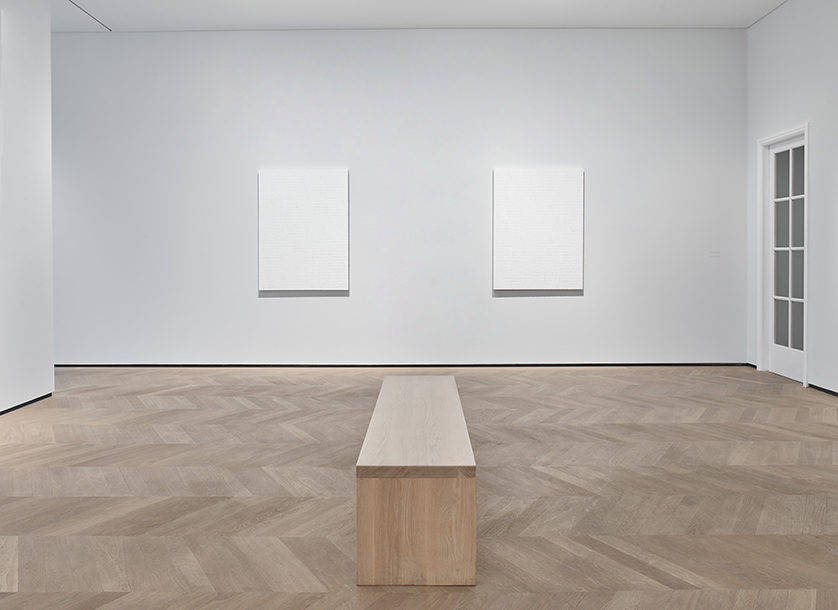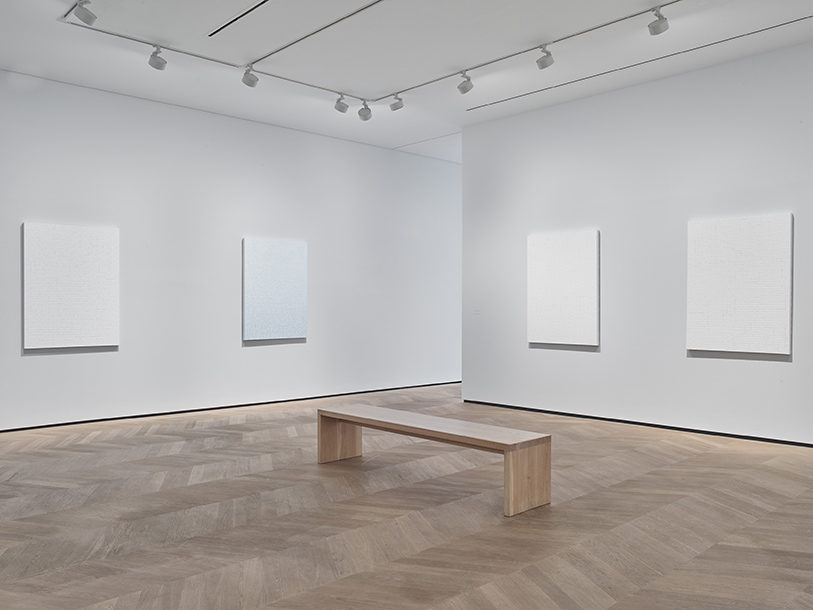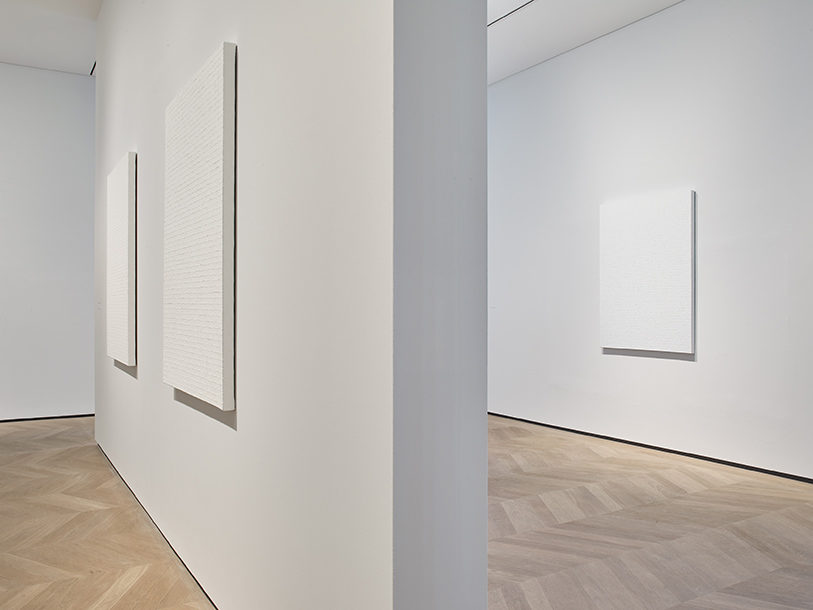Chung Sang-Hwa
Chung Sang-Hwa
Chung Sang-Hwa is a central figure of Dansaekhwa (also known as Tansaekhwa), a central artistic development in postwar Korea that offered a fundamentally different approach to modernist abstraction. Though the term translates literally to “monochrome painting,” Dansaekhwa is rather characterized by its labor-intensive processes, repetitive gestures, and reductionist aesthetics. Rooted in the Korean informel style of the late 1950s to mid-’60s, Dansaekhwa emerged in Korean institutions and galleries in the 1970s and has been attributed to the work of a loose constellation of artists that also includes Park Seo-Bo, Lee Ufan, and Yun Hyong-Keun. Over his nearly six-decades-long career, Chung has developed a singular, meditative process of repetitively applying and removing paint from his canvases, resulting in multilayered, tactile monochromatic surfaces.
Born in 1932 in Yeongdeok, Korea, during Japanese colonial rule, Chung witnessed decades of tumultuous political and social transformations in his native Korea. He studied oil painting at Seoul National University, making canvases featuring dark palettes as a response to the fear and instability wrought by the Korean War (1950–53). As a student, short on materials, he would buy charcoal powder and mix it with oil to make paint; soon he sourced kaolin (powdered stone produced in the Gaoling region of China), which remains the core material of his practice. He graduated in 1956, three years after a truce brought an uneasy end to combat. In this moment of postwar reconstruction, art education and discourses in South Korea were reckoning with the legacy of Japanese imperial bureaucracy, which distinguished media according to materials and separated traditional ink painting from “Western” oil painting. These divisions were complicated by Dansaekhwa artists, who embraced abstraction and its internationalism as the Korean art scene developed in the 1960s. Employed as an art educator at a teacher’s college after graduation, Chung painted in his studio late into the night, studying reproductions of European and American art in books and periodicals. He worked in the Korean informel style, creating colorful, palimpsestic compositions with gestural marks that engage the negative space of exposed canvas, anticipating the work that would come to define his career.
Chung mounted his first solo exhibition in 1962, at the Central Report Institute in Seoul, and the following year, Galerie Lambert in Paris held his first presentation outside of South Korea, Les jeunes peintres coréens, alongside Park Seo-bo and two other Korean artists. In 1967, Chung moved to Paris, where he refined his unorthodox techniques in an environment more amenable to artistic experimentation. He took French language lessons at the L'Alliance française Paris and diligently visited museums and galleries. In 1968, his first solo exhibition in Paris was presented at Galerie Jean Camion, and in 1969, he relocated to Kobe, Japan, where he became acquainted with the work of artists such as Jiro Yoshihara, Kazuo Shiraga, and others associated with the avant-garde Gutai group. There, he “opened his eyes to the canvas,” as he has described, developing his ritual of painting, folding, cracking, striping, and repainting as a mode of self-exploration.
By the mid-’70s, Dansaekhwa had become a dominant force in Korea and found international traction with significant exhibitions in France and Japan, where Chung mounted numerous solo presentations throughout the decade, including those at Shinanobashi Gallery in Osaka (1969, 1973); Motomachi Gallery in Kobe (1971, 1977); Mudo Gallery (1972) and Muramatsu Gallery (1973) in Tokyo; and Coco Gallery in Kyoto (1977). In the late ’70s, he arrived at his signature monochromatic gridded paintings. To create them, first, he applies ten or more thick layers of paint, glue, and kaolin clay to a stretched canvas; once dry, he unmounts the canvas and draws linear grids on its verso. He alternately rolls, compresses, folds, or scores the canvas to crack its façade before tearing off passages of dried paint with a knife. He then fills in the negative areas with acrylic paint. This process is repeated in various iterations, such that the surface cracks unpredictably as it dries at multiple rates. As art historian Joan Kee has described, Chung has approached painting “not just as an object, but as a question of time…Not only is there repetition, but there are long periods of waiting—waiting for paint to dry, to peel, to chip away, and so forth. His work may be described in some way as an aesthetic of accumulation. There is density of material, but also density of duration." In 1976, Chung returned to Paris, where he lived and worked for fifteen years before settling into a studio in the mountains of Yeoju, South Korea, where he continues to work today, surrounded by nature.
Chung's work has been exhibited extensively in Korea and internationally since the 1960s. In 2011, his solo exhibition Chung Sang-Hwa: Painting Archeology was mounted at the Musée d’Art Moderne de Saint-Étienne Métropole in France. He has participated in the Paris Biennale (1965), São Paulo Bienal (1967, 1973), Gwangju Biennale (2000), and the Mediations Biennale, Poznań, Poland (2008). His work has been included in notable group exhibitions such as Korean Drawing Now at the Brooklyn Museum (1981); Contemporary Korea Painting, which opened at the National Museum of Modern Art, Gwacheon, South Korea, and traveled to Ljubljana and Sarajevo (1991); Poetry in Motion, presented at Galerie Beyeler, Basel, and Gallery Hyundai, Seoul (2007); From All Sides: Tansaekhwa on Abstraction at Blum & Poe, Los Angeles (2014); and Dansaekhwa at the Palazzo Contarini-Polignac, Venice (2015).
Chung’s work is held in the permanent collections of the Art Institute of Chicago; Busan Museum of Art; Fukuoka Asian Art Museum; Guggenheim Abu Dhabi; Hirshhorn Museum and Sculpture Garden, Smithsonian Institution, Washington, DC; Leeum, Samsung Museum of Art, Seoul; M+, Hong Kong; Musée d’Art Moderne et Contemporain, Saint-Étienne Métropole, France; National Museum of Modern and Contemporary Art, Korea, Gwacheon; National Museum of Modern Art, Tokyo; Seoul Museum of Art; Shizuoka Prefectural Museum of Art, Japan; and the Tokyo Museum of Contemporary Art, among others.
In 2016, Dominique Lévy and Greene Naftali galleries jointly presented Chung’s first solo exhibition in the United States in New York, surveying his work from 1969 to 2014. This presentation was accompanied by a fully illustrated catalogue featuring contributions by poet Yuko Otomo and art historian Tim Griffin. In conjunction with the exhibition and publication, Dominique Lévy hosted a discussion with the artist, Griffin, and the critic Robert C. Morgan. In 2017, Lévy Gorvy London presented a selection of new works in the exhibition Chung Sang-Hwa: Seven Paintings.
Selected Works
Video
Chung Sang-Hwa: Excavations, 1964-78 (2020)
January 30, 2020
Exhibitions
Chung Sang-Hwa: Excavations, 1964–78
London
February 28 - April 25, 2020
Chung Sang-HwaChung Sang-Hwa: Excavations, 1964–78
New York
November 11, 2019 - January 18, 2020
Chung Sang-HwaChung Sang-Hwa: Seven Paintings
London
May 24 - August 17, 2017
Chung Sang-HwaChung Sang-Hwa
New York
June 1 - July 30, 2016
Publications
Selected Press
The Brooklyn Rail | Border Crossings
July 10, 2021
Insight Korea | [Insight Fine Art]화가 정상화‥“슬쩍 지나가면서 머릿속에 남는 이미지”
July 2, 2021
The Korea Herald | MMCA celebrates Chung Sang-hwa’s 60-year art career
May 24, 2021
Korea JoongAng Daily | Modern monochrome
May 23, 2021
Ocula | Taipei Connections: Eleven Works to Collect
May 6, 2020
Artlyst | Chung Sang-Hwa: Excavations, 1964–78
March 2, 2020
Art Daily | Exhibition presents paintings from a formative era of Chung Sang-Hwa’s five-decades-long career
January 1, 2020
State of the Arts NYC | CHUNG SANG-HWA: EXCAVATIONS, 1964-78
November 15, 2019
NY Art Beat | Chung Sang-Hwa “Excavations, 1964–78”
November 15, 2019
FAD Magazine | GalleriesNow Top Exhibitions of the Week: London, Paris and New York
November 15, 2019
news is | 정상화 화백, 뉴욕 레비고비 갤러리서 세번째 개인전
November 15, 2019
Art Rabbit | EXHIBITION just opened
November 11, 2019
Galleries Now | Chung Sang-Hwa: Excavations, 1964-78
October 28, 2019
NY Culture Beat | Chung Sang-Hwa: Excavations, 1964-78
October 25, 2019
Galleries Now | Weekender: Exhibition Top Picks
August 11, 2017
Blouin Artinfo | Chung Sang-Hwa at Lévy Gorvy, London
August 4, 2017
Financial Times | Critics' Choice: Chung Sang-Hwa
May 27, 2017
Artlyst | Chung Sang-Hwa: Seven Paintings
May 23, 2017
ArtAsiaPacific | Chung Sang-Hwa
July 28, 2016
Blouin Artinfo | Chung Sang-Hwa Holds First US Solo Show at Dominique Lévy
June 12, 2016
Financial Times | The comeback kings and queens of art
May 20, 2016
Korea Times | Chung Sang-Hwa seeks aesthetics of accumulation
March 27, 2016
More Information
Artists
Alexander Calder
Enrico Castellani
Chung Sang-Hwa
Francesco Clemente
Dan Colen
Willem de Kooning
Lucio Fontana
Gego
Yves Klein
Jutta Koether
Seung-taek Lee
Robert Motherwell
Senga Nengudi
Roman Opalka
Adrian Piper
Michelangelo Pistoletto
Carol Rama
Martial Raysse
Peter Regli
Germaine Richier
Karin Schneider
Joel Shapiro
Kazuo Shiraga
Pierre Soulages
Pat Steir
Tu Hongtao
Günther Uecker
Zao Wou-Ki
Specializing in Works By
- Terry Adkins
- Vincenzo Agnetti
- Carl Andre
- Diane Arbus
- Jean Arp
- Francis Bacon
- John Baldessari
- Jean-Michel Basquiat
- Alighiero Boetti
- Lee Bontecou
- Louise Bourgeois
- Mark Bradford
- Constantin Brancusi
- Cecily Brown
- Alberto Burri
- Sérgio Camargo
- Vija Celmins
- John Chamberlain
- Eduardo Chillida
- Lygia Clark
- George Condo
- Joseph Cornell
- Gino de Dominicis
- Nicolas de Staël
- Richard Diebenkorn
- PETER DOIG
- Jean Dubuffet
- Sam Francis
- Helen Frankenthaler
- Lucian Freud
- Alberto Giacometti
- Gilbert & George
- Johannes Girardoni
- Sonia Gomes
- Julio González
- Arshile Gorky
- Adolph Gottlieb
- Mark Grotjahn
- Philip Guston
- David Hammons
- Keith Haring
- Damien Hirst
- David Hockney
- Thomas Houseago
- Jasper Johns
- Donald Judd
- Ellsworth Kelly
- Anselm Kiefer
- Martin Kippenberger
- Franz Kline
- Jeff Koons
- Jannis Kounellis
- Lee Krasner
- Barbara Kruger
- Yayoi Kusama
- Gerald Laing
- Fernand Léger
- Roy Lichtenstein
- Liza Lou
- Tsuyoshi Maekawa
- René Magritte
- Piero Manzoni
- Brice Marden
- Agnes Martin
- Henri Matisse
- Fausto Melotti
- Joel Mesler
- Eleanore Mikus
- Joan Miró
- Joan Mitchell
- Amedeo Modigliani
- Piet Mondrian
- Paulo Monteiro
- Henry Moore
- François Morellet
- Bruce Nauman
- Barnett Newman
- Albert Oehlen
- Claes Oldenburg
- Francis Picabia
- Pablo Picasso
- Lari Pittman
- Sigmar Polke
- Jackson Pollock
- Richard Prince
- Robert Rauschenberg
- Charles Ray
- Ad Reinhardt
- Gerhard Richter
- Jean Paul Riopelle
- Mark Rothko
- Ed Ruscha
- Robert Ryman
- Salvatore Scarpitta
- Thomas Schütte
- Richard Serra
- Cindy Sherman
- Jeff Sonhouse
- Clyfford Still
- Rudolf Stingel
- Mark Tansey
- Mickalene Thomas
- James Turrell
- Cy Twombly
- Andy Warhol
- Tom Wesselmann
- Franz West
- Jonas Wood
- Christopher Wool














